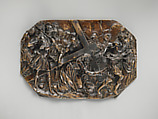Christ bearing the cross
Ferdinando Tacca Italian
This bronze relief represents Christ collapsing under the weight of the cross on the road to Golgotha, the place of his crucifixion, and specifically the moment when the Roman soldiers “seized a man, Simon of Cyrene, who was coming from the country, and they laid the cross on him, and made him carry it behind Jesus” (Luke 23:26). Along with the two protagonists at the center, twelve figures are arrayed across the packed rectangular space, including several armored soldiers in different poses, the weeping Virgin in the rear, and a male figure wearing a turban on the right. That the object was intended for private devotion is suggested by its small size and the dramatic composition designed to elicit empathy and compassion. The leftward thrust of the bodies leads the viewer’s eye to the central figures, inviting the devotee to identify with Simon as he assists Christ. Their faces are inclined at the same angle parallel to the diagonal of the crossbar. The forward motion is halted by the woman on the right whose back is turned to the scene as if it were too painful to witness, and our eyes circle back to the man at the left whose gaze again directs us to Christ’s suffering. Such a relief would have been perfectly suited to a mounting as a sort of predella under a precious cross (croce da tavolo), like the painted miniature of the same subject installed in the small altar donated by Pope Clement VIII to Vincenzo I Gonzaga in 1598 and now in the Museo Diocesano, Mantua.[1]
At least three other versions of the relief are known, each of a slightly different size and shape: in the Minneapolis Institute of Art, the Spencer Museum of Art in Lawrence, Kansas, and the Wernher Collection at Luton Hoo.[2] The Met’s plaque is the finest, whereas those in Minneapolis and Lawrence exhibit a rougher finish. The model was first tentatively attributed to the Nuremberg sculptor Christoph Jamnitzer by Ulrich Middeldorf and Oswald Goetz, who noted, however, that “the proportions of the figures and the treatment of the detail point to a German familiar with Venetian art.”[3] Anthony Radcliffe considered the model fully Florentine and ascribed it to Ferdinando Tacca, an attribution accepted by James David Draper, who published our bronze in 1984.[4] Recent scholars have given the invention to Francesco Fanelli.[5] The elongated figures and exoticizing touches such as the turban certainly can be related to other products by Fanelli and his workshop,[6] though his style still eludes precise definition.[7] Here, Christ’s dominating figure, wrapped in a large, flowing tunic, his agonized face projecting from the surface into the viewer’s space, might have been inspired by Alessandro Algardi’s frequently copied rendition of the subject.[8]
Evidence in favor of the attribution of our plaque to Fanelli is the description of a bronze relief representing Christ carrying the cross as by “a sculptor of Genoa” in the inventory of the third duke of Alcalá (1583–1637). Fanelli, born in Florence, is documented in Genoa in 1609–10.[9] In the duke’s inventory, the relief is paired with an Adoration of the Magi of the same size, several casts of which have been identified (and recently interpreted as an episode of the Flight into Egypt based on apocryphal gospels).[10] Further support for Fanelli’s authorship is provided in the 1689 inventory of the Genoan nobleman Vincenzo Spinola, which mentions “a bronze low relief by the Fiorentino [as Fanelli was nicknamed] representing Our Lord carrying the Cross to the Golgotha” that was mounted on a small wood altar decorated with wax figurines.[11] This relief by “the Fiorentino” might be one of the versions of the present bronze.
According to Richard Stone, the reverse of our relief has numerous stubs of casting gates, indicating that it was likely cast face down.[12] The casting is of high quality, thin and quite conformal. While virtually all Italian Renaissance bronzes contain traces of nickel, the conspicuously greater amount here suggests that the relief was not made in Italy. As is well known, Fanelli was active in both Flanders and England.
-FL
Footnotes
(For key to shortened references see bibliography in Allen, Italian Renaissance and Baroque Bronzes in The Metropolitan Museum of Art. NY: The Metropolitan Museum of Art, 2022.)
1. See Venturelli 2012, pp. 215–17, cat. 69.
2. A fourth, less finished rectangular version was at Sotheby’s, London, July 8, 2005, lot 65.
3. Middeldorf and Goetz 1944, p. 53, no. 385.
4. Radcliffe 1976, p. 23 n. 22.
5. See Stock 2004, who mentions the version in Minneapolis. The other versions too are now attributed to Fanelli on the respective museum websites. Draper accepted the attribution in 2014 (ESDA/OF).
6. I am thinking, for instance, of the elastic pose of the Conversion of Saint Paul, a small bronze attributed to Fanelli’s workshop in Seitun 2018, p. 85.
7. See Stock 2004; Sanguineti 2014; Seitun 2018.
8. On Algardi’s model, see Montagu 1985, vol. 2, pp. 322–24.
9. See the pair of reliefs in the Minneapolis Institute of Art, 66.43.1,.2. Boccardo 2003, p. 318; Victoria Avery in V. Avery and Dillon 2002, pp. 172–75.
10. Boccardo 2003, p. 319.
11. R. Stone/TR, June 20, 2011. The relief was cast in a quaternary alloy of copper, zinc, tin, and lead.
Due to rights restrictions, this image cannot be enlarged, viewed at full screen, or downloaded.

